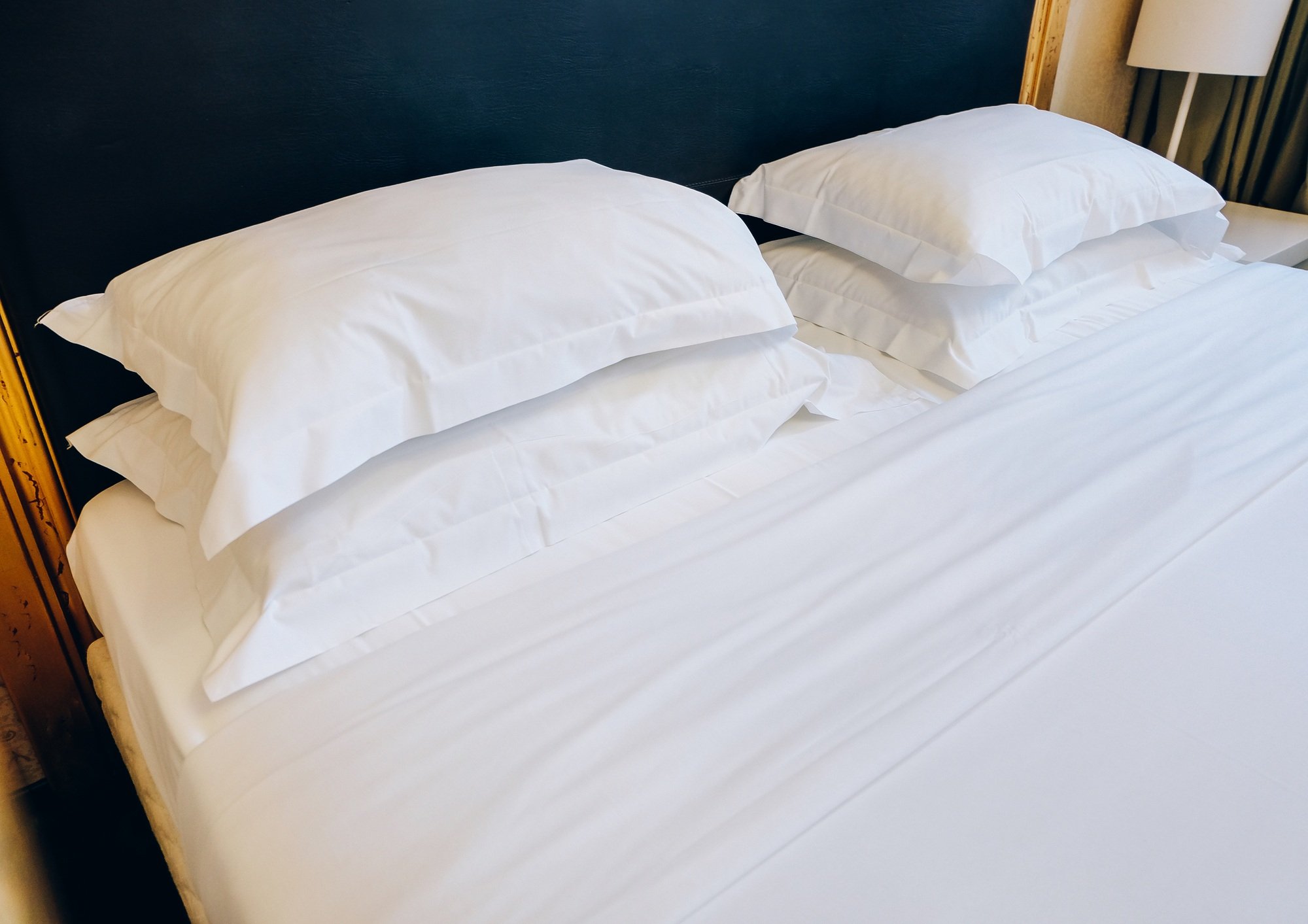Sleepers who struggle with overheating at night know how uncomfortable it can be to find the right bedding. You need cooling sheets that effectively regulate your body temperature while providing comfort and durability. In this guide, you’ll learn how to identify the key features that make cooling sheets ideal for hot sleepers, from breathable fabrics to moisture-wicking properties. By considering these factors, you can enhance your sleep quality and stay comfortably cool throughout the night in 2025 and beyond.
Decoding the Science Behind Cooling Sheets
Cooling sheets utilize advanced textile technology and natural fibers to actively manage your body temperature as you sleep. By combining breathable construction with moisture-wicking abilities, these sheets help dissipate heat and evaporate sweat quickly. Materials such as cotton, linen, bamboo fiber, and phase change materials (PCMs) each contribute unique properties that regulate temperature, reduce overheating, and enhance overall sleep comfort, letting you maintain a balanced thermal environment throughout the night.
Innovative Materials that Make a Difference
Materials like PCM and bamboo fiber stand out for their technical innovations—PCMs absorb excess heat and release it back when your body cools, while bamboo fiber offers exceptional moisture absorption and antibacterial benefits. Natural fabrics like cotton and linen excel in breathability and sweat evaporation, creating a fabric blend that efficiently transfers heat away from your skin and keeps you dry, even during intense night sweats.
How Temperature Regulation Enhances Sleep Quality
Controlling your body temperature directly impacts how quickly you fall asleep and how deeply you rest. Cooling sheets stabilize your skin’s surface temperature, preventing disruptive heat buildup that causes tossing and waking. This regulated thermal environment supports your body’s natural circadian rhythm, leading to less interrupted sleep cycles and improved daytime alertness.
| Temperature Regulation Benefit | How It Works |
|---|---|
| Better Sleep Onset | Sheets dissipate heat quickly, helping you fall asleep faster by maintaining an optimal skin temperature around 31–33°C (88–91°F). |
| Reduced Nighttime Awakenings | Consistent cooling prevents overheating, minimizing tossing and turning caused by discomfort. |
| Enhanced Sleep Depth | Stable body temperature supports uninterrupted REM and deep sleep stages, crucial for recovery and memory consolidation. |
| Improved Daytime Energy | Quality sleep fostered by temperature regulation leads to better focus and mood throughout the day. |
Optimizing your sleep environment with cooling sheets helps align your body’s thermoregulation more closely with its natural patterns. When your skin temperature remains within the ideal range, your core body temperature can drop as intended during sleep cycles, enhancing both sleep quality and duration. This scientific balance reduces the effects of heat-induced discomfort and allows you to wake feeling refreshed and rejuvenated.
Recognizing the Signs You Need Cooling Bedding
Frequent night sweats, tossing and turning due to overheating, or waking up feeling clammy are clear indicators your current bedding isn’t keeping your body temperature in check. If you notice these symptoms regularly disrupting your rest, cooling sheets can offer significant relief. These specialized sheets absorb moisture and enhance airflow, helping to maintain a stable, comfortable temperature. By responding to these signs early, you can avoid prolonged sleep disturbances and improve overall sleep quality.
Identifying Symptoms of Night Sweats
If you regularly wake up with damp sheets or your pajamas sticking uncomfortably to your skin, you’re likely experiencing night sweats. This excess sweating during sleep creates a clammy, cold sensation that makes it harder to fall back asleep. Cooling sheets featuring moisture-wicking fabrics like bamboo or cotton quickly absorb sweat and facilitate evaporation, keeping you dry and comfortable through the night.
Understanding the Impact of Overheated Sleep Environments
Sleeping in an overheated environment forces your body to work harder to cool down, which interrupts the natural sleep cycle and causes frequent awakenings. Temperatures above 75°F (24°C) can significantly reduce deep REM sleep, which is vital for cognitive function and physical recovery. Cooling sheets help maintain an optimal skin temperature by promoting airflow and dissipating heat, allowing you to stay asleep longer and wake up more refreshed.
Extended periods of overheating during sleep reduce sleep duration and impair sleep efficiency, leading to daytime fatigue and decreased concentration. Studies show that a cooler sleeping surface, maintained by breathable, moisture-wicking materials, can lower core body temperature by as much as 1–2 degrees Fahrenheit. This temperature drop supports the body’s natural thermoregulation process, enabling smoother transitions between sleep stages and enhancing overall restfulness.

Essential Features for Optimal Sleep Comfort
Choosing cooling sheets that combine breathability, moisture-wicking ability, softness, eco-friendliness, and durability ensures a restful night without overheating or discomfort. Exploring options like cotton, bamboo, or advanced phase change materials can dramatically enhance your sleep quality. You can find detailed reviews and comparisons in The 8 Best Cooling Sheets, Tested by Hot Sleepers, offering insights that help you make an informed choice tailored to your specific cooling needs.
Breathability and its Role in Temperature Control
| Feature | Benefit |
|---|---|
| Natural Fibers (Cotton, Linen) | Allow maximum air circulation, dispersing body heat efficiently to keep you cool. |
| Loose Weave | It facilitates sweat evaporation, thereby reducing dampness and lowering skin temperature. |
| Moisture Permeability | It prevents the trapping of heat, thereby promoting a fresher sleep environment throughout the night. |
| Lightweight Construction | Prevents trapping heat, supporting a fresher sleep environment throughout the night. |
Sheets crafted from materials like linen and high-quality cotton use open weaves and breathable fibers to naturally dissipate heat. This continuous airflow helps stabilize your body temperature, minimizing disruptions caused by overheating during sleep.
Importance of Moisture-Wicking Properties
Cooling sheets featuring moisture-wicking technology pull sweat away from your skin and expel it quickly into the air, reducing clamminess and discomfort. This keeps you dry and helps maintain a stable microclimate close to your body, which is imperative for deep, uninterrupted sleep even in warm conditions.
Effective moisture management goes beyond absorption; it accelerates evaporation to prevent moisture buildup that can interrupt your sleep and cause skin irritation. Materials like bamboo fiber excel here, combining antibacterial properties with superior moisture-wicking, ensuring you stay cool, dry, and comfortable all night long.
Eco-Friendly Choices for Sustainable Comfort
Eco-conscious hot sleepers are increasingly turning to sustainable bedding options that combine comfort with environmental responsibility. Bamboo and recycled fibers stand out for their renewable origins and minimal ecological footprints, providing excellent moisture-wicking and cooling benefits. You can explore top-rated selections in the 9 Best Cooling Sheets of 2025, Tested and Reviewed by AD to find eco-friendly options that don’t compromise on quality or temperature regulation.
The Rise of Bamboo and Sustainable Fabrics
Bamboo’s popularity in cooling sheets grows due to its rapid renewability and natural antibacterial properties. Unlike traditional cotton, bamboo cultivation requires less water and no pesticides, making its fibers a sustainable choice for bedding. Sustainable fabrics made from recycled or organic materials now offer durability and softness on par with conventional sheets, addressing the needs of hot sleepers while respecting the planet.
Evaluating the Environmental Impact of Your Bedding
Assessing the full environmental footprint of cooling sheets involves considering production methods, resource consumption, and end-of-life recyclability. Sheets certified by programs like OEKO-TEX® or GOTS ensure harmful chemicals are minimized. Paying attention to these certifications helps you choose bedding that supports both your sleep quality and sustainable living goals.
Beyond certifications, manufacturing processes influence the overall environmental impact significantly. For example, organic cotton sheets reduce pesticide use but can sometimes consume more water, whereas bamboo’s eco-advantages stem from its fast growth and minimal irrigation. Additionally, the durability of the sheets affects sustainability; long-lasting fabrics reduce waste and the frequency of replacement. Incorporating products made from recycled fibers further decreases reliance on virgin resources. When you prioritize these factors, your bedding choices contribute to a lower carbon footprint and healthier ecosystems without sacrificing comfort.

Maintenance Tips for Longevity and Performance
Maintaining the cooling properties of your sheets depends largely on proper care routines. Use gentle, cold-water washes to prevent fiber breakdown, and avoid harsh detergents that strip moisture-wicking finishes. Air drying or low-heat tumble drying helps preserve fabric integrity, while frequent washing removes accumulated sweat and oils that can clog breathable fibers. Avoid bleach or fabric softeners, as these chemicals can damage delicate materials like bamboo or PCM-infused fabrics. Any neglect in care can reduce breathability, decrease softness, and compromise your sheets’ cooling effectiveness over time.
Caring for Your Cooling Sheets: Best Practices
Washing cooling sheets in cold water with mild, fragrance-free detergent preserves both softness and moisture-wicking abilities. Use a gentle cycle to minimize fiber stress, then either line dry them or tumble dry on low heat to prevent shrinkage and maintain fabric structure. Spot-treat stains promptly to avoid the build-up of residues that might hinder cooling performance. Rotating between multiple sheet sets can also decrease wear and extend their life, allowing you to enjoy consistent comfort night after night.
How Improper Care Affects Efficiency
Improperly washing or drying cooling sheets can cause irreversible damage to their breathable and moisture-wicking qualities. Hot water and harsh detergents often degrade fibers such as bamboo or PCM blends, reducing their ability to regulate temperature effectively. Additionally, fabric softeners and bleach may coat or weaken fibers, blocking airflow and moisture evaporation. Such degradation leads to reduced ventilation and increased heat retention, directly undermining the performance you rely on for a cool night’s sleep.
Repeated use of strong detergents or excessive heat breaks down natural and high-tech fibers alike, causing pilling and loss of fabric softness. Over time, your sheets might feel stiff or rough, and their cooling mechanisms can fail to keep you dry and comfortable. Moisture-wicking layers clogged by oils and dirt further trap heat, contributing to the very night sweats and restlessness you aimed to eliminate. Proper care routines, including gentle cleansers and low-heat drying, ensure your cooling sheets maintain their advanced temperature control and comfort features throughout their lifespan.
Conclusion
On the whole, choosing the best cooling sheets for hot sleepers in 2025 means focusing on breathable, moisture-wicking, and temperature-regulating materials like cotton, linen, bamboo, or PCM fabrics. You should prioritize softness and durability while also considering eco-friendly options to support both your comfort and sustainability goals. By selecting sheets that maintain stable body temperature and manage night sweats effectively, you can enhance your sleep quality significantly and wake up feeling refreshed and energized every day.
FAQ
Q: What materials should I prioritize when choosing the best cooling sheets for hot sleepers in 2025?
A: When opting for cooling sheets for hot sleepers, focus on materials that offer breathability, moisture-wicking, and temperature regulation. Natural fabrics like cotton and linen allow air circulation and effectively evaporate sweat. Advanced materials such as phase change materials (PCM) adapt to body temperature by absorbing and releasing heat, while bamboo fiber offers softness, moisture absorption, and antibacterial benefits. These materials help maintain a comfortable sleep temperature throughout the night.
Q: How important is moisture-wicking ability in cooling sheets for enhancing sleep quality?
A: Moisture-wicking is key to staying dry and comfortable while sleeping, especially for hot sleepers who sweat during the night. Cooling sheets that excel in wicking moisture pull sweat away from your skin and promote rapid evaporation. This function helps regulate body temperature and prevents discomfort caused by damp bedding, which can disrupt sleep. Sheets with moisture-wicking properties contribute to deeper, more restful sleep every night.
Q: What additional features should I consider, apart from the material, when selecting cooling sheets?
A: Besides selecting the right materials, it’s beneficial to look for factors such as softness, eco-friendliness, and durability. Softness supports comfort and is especially important for those with sensitive skin; bamboo fiber and high-quality cotton are generally gentle choices. Eco-friendly sheets made from bamboo or recycled fibers offer sustainability alongside comfort. Durability ensures your sheets maintain cooling performance over time, so opting for products with high weave counts and certifications like OEKO-TEX® can help you invest in long-lasting bedding.






















